BIOL 2390 - Topic 4
1/66
Earn XP
Description and Tags
organismal ecology
Name | Mastery | Learn | Test | Matching | Spaced |
|---|
No study sessions yet.
67 Terms
what environments might have little variation?
marine + aquatic are more stable - less variation as compared to terrestrial
name common stressors
climatic stressors ex. long term weather patterns
chemical stressors ex. pollutants, oxygen availabilty
physical stressors ex. wind, water current
biological stressors ex. competition, disease
explain the effects stressors can have at the different levels
individual response: loss of productivity
population level: alteration of gene pool
community level: loss of vulnerable species, opening of niches that can be filled by tolerant species, negatively affect biodiversity
what is reproductive potential, and what is it determined by?
maximum number of potential offspring and is determined by genotype
what affects the actual reproductive success
many environmental stressors can limit performance - physiology, morphology, behavior.
define tolerance
when stressors have lower impact on organisms
define resilience
when organisms can recover after stressor is removed
what 4 main patterns do degree of response to stress follow ?
little tolerance - type A response
direct relationship - type B response
resistance/tolerance - type C response
high tolerance - type D response
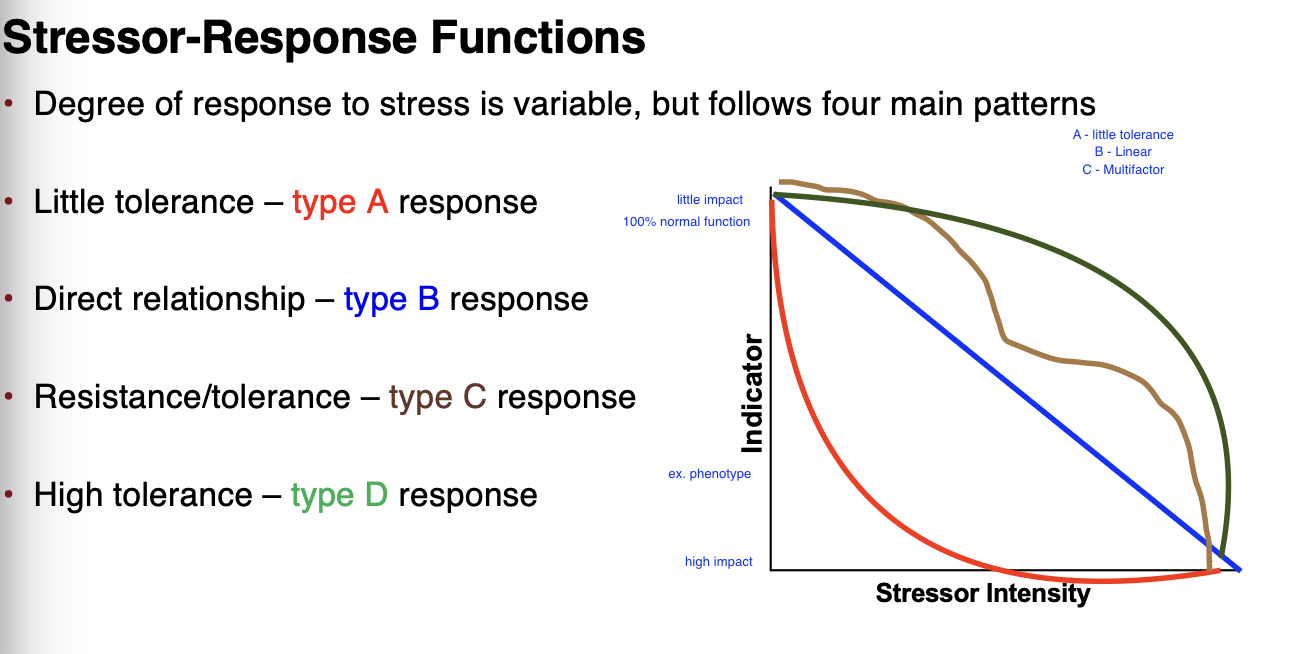
what are the 3 responses to stress
developmental response
acclimatory responses
regulatory responses
describe developmental response
irreversible change lasts for the life span (could be years)
descibe acclimatory responses
can last from days - weeks and are reversible
describe regulatory responses
real-time changes that can last seconds - minutes
in response to changing environments, organisms can be conformers vs regulators
reversible changes allow for homeostasis
what 2 processes occur simultaneously in leaves ?
photosynthesis + cellular respiration
light reactions only occur when _ is available? what is produced ?
PAR : photosynthetically active radiation
CO2 consumption (fixed) as sugars are produced
what happens if PAR is not present ? what is the net CO2 uptake ?
only respiration occurs; net CO2 uptake is negative
what effects can stressors have on organisms? (3)
reproductive potential
tolerance
resilience
what 2 processes does photosynthesis consist of?
Light reactions and the calvin cycle
light reactions: where does energy come from ?
Photosynthetically active radiation (PAR) = light
where do electrons for light reactions come from ?
water
what is the carbon source for Calvin Cycle?
CO2
Calvin cycle: where does energy come from?
light reactions
what does cellular reproduction produce ?
CO2
What happens to CO2 uptake when PAR increases?
CO2 uptake increases
define light compensation point
when fixation = respiration
(no net gain or loss)
light compensation point vs low-shade plants
have a low LCP – they can survive in low light.
light compensation point vs sun loving plants
have a higher LCP – they need more light to break even.
define light satuation point
light intensity at which the rate of photosynthesis reaches its maximum and no longer increases even if more light is provided.
explain what happens when were below the light saturation point
More light = faster photosynthesis (light is the limiting factor)
explain what happens when were above or at the light saturation point
Photosynthesis plateaus because another factor (like CO₂, temperature, or enzyme activity) becomes limiting.
sun loving plants vs LSP
have a high LSP — they can use high light levels efficiently.
shade plants vs LSP
each LSP at lower light intensities — too much light can actually stress them.
define gross photosynthesis
total amount of carbon dioxide (CO₂) fixed (or oxygen produced) by a plant during photosynthesis before subtracting the CO₂ lost to respiration.
define net photosynthesis
the difference between CO2 uptake and respiration
usable energy the plant has left over for growth, storage, and reproduction after meeting its own energy needs.
t max happens when … (graph)
where the lines cross
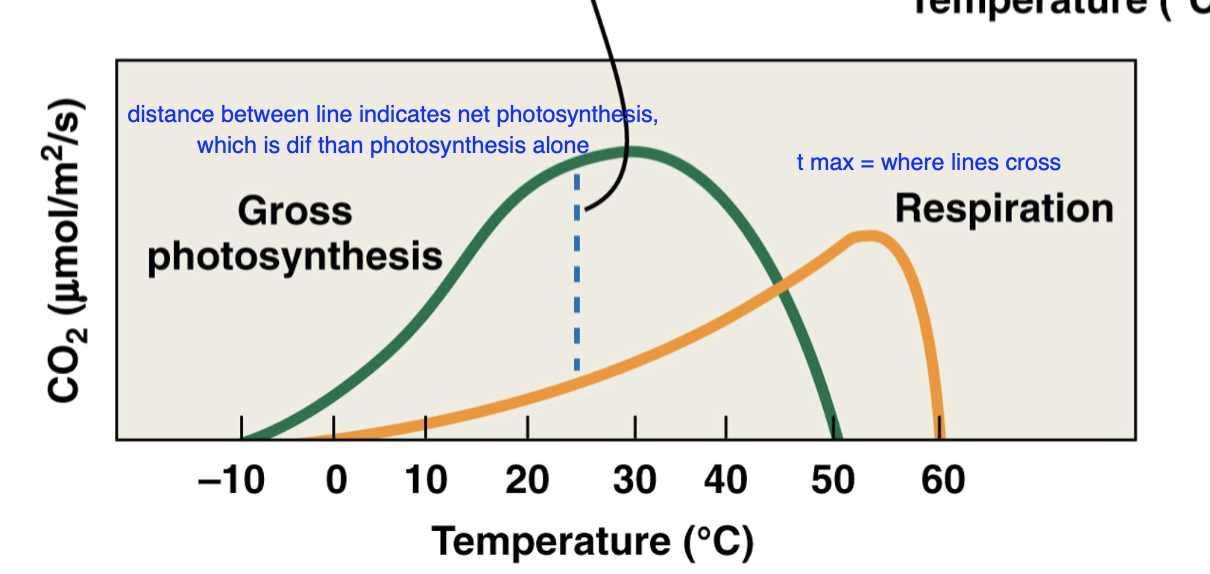
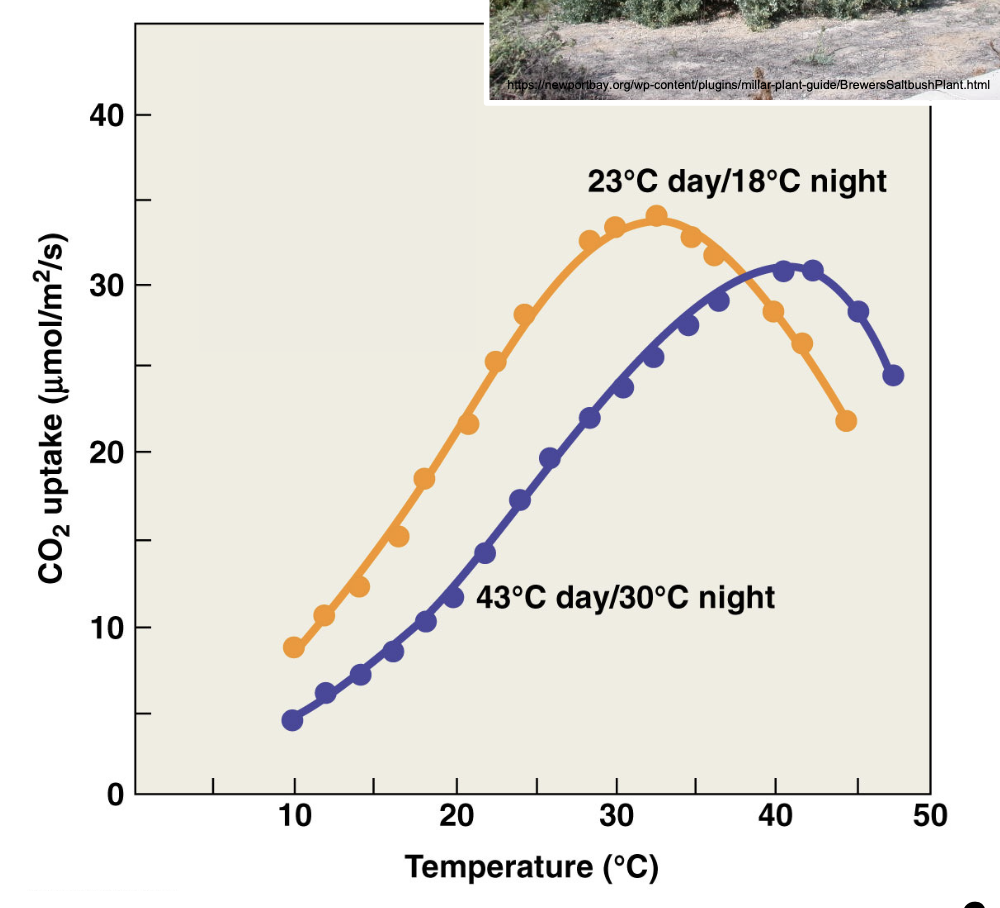
this graph demonstrates what? and what response ?
-population of a species can adapt to local environmental pressures
demonstrates that Topt shifts as individuals adapt
acclimatory response
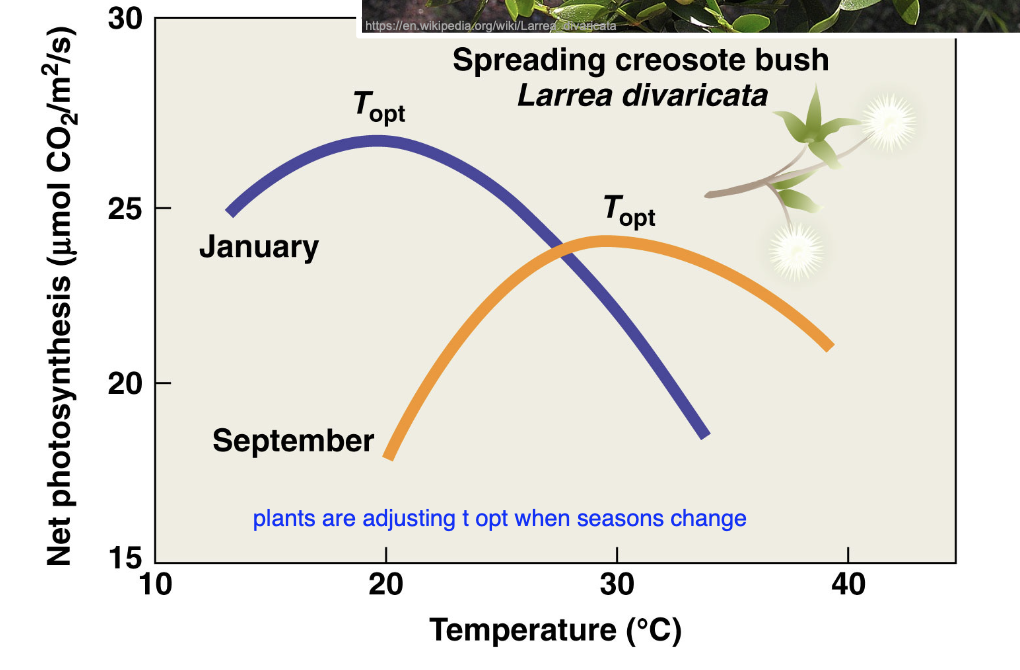
this graph demonstrates what? what response ?
some species can adapt to seasonal environmental pressures
Topt shifts as individuals acclimate to seasonal change
acclimatory response
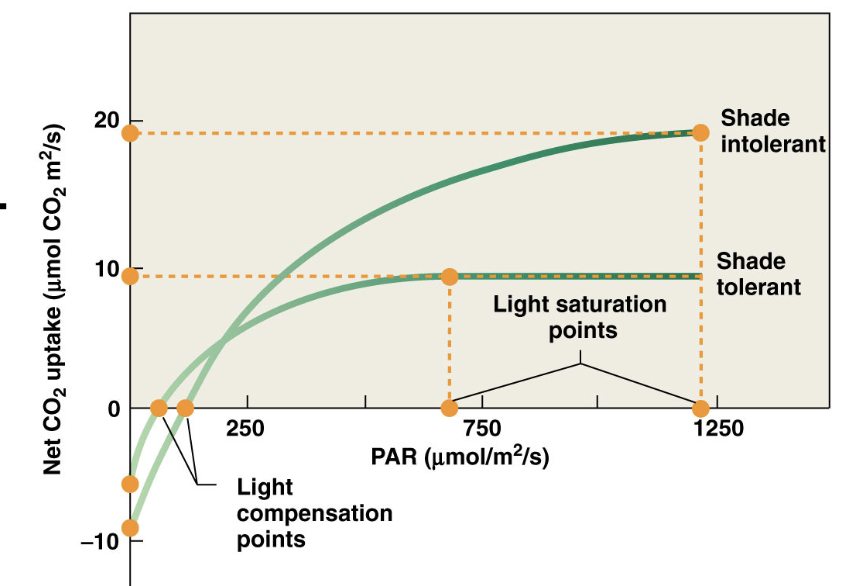
interpret this graph :
shade tolerant:
LSP, net co2 uptake at LSP
shade intolerant:
LSP, net co2 uptake at LSP
shade tolerant:
LSP: (~700 mol) net co2 uptake at LSP (10 mol)
shade intolerant:
LSP (~1200 mol) , net co2 uptake at LSP (19 mol)
Shade-tolerant plants:
rubisco levels → results in what regarding LSP, growth and photosynthesis rates?
energy demands
rate of respiration
LCP
rubisco levels: Less rubisco required → results in what Lower LSP meaning organism stays small, slower growth rates and limited photosynthesis rates
Lower energy demands
lower rate of respiration
smaller LCP
boundary layer
is a barrier to heat loss. the thin layer of still or slow-moving air (or fluid) that forms right next to a surface, like a leaf, skin, or building wall.
what mechanism cools leaves ?
convective heat loss: When air or water moves past a warm object, it carries heat away.
- heat lost due to movement of the fluid.
what influences thickness of boundary layer?
size and shape
thick boundary layers - who benefits ?
Slower exchange of heat, water vapor, CO₂/O₂
Desert plants, dry environments
thin boundary layers - who benefits?
Faster exchange (cooling, transpiration, gas uptake)
Tropical rainforest plants
simple leaves vs boundary layer
Larger continuous surface area
Thicker boundary layer forms across the surface
Slower gas and heat exchange
advantages:
Better water conservation
Useful in dry or cold environments where reducing transpiration or heat loss is key
compound leaves vs boundary layer
Thinner boundary layer around each leaflet due to greater air flow
Faster gas exchange and cooling
advantages:
Enhanced photosynthesis and cooling
More efficient in hot, humid, or well-ventilated environments
Why is the Calvin cycle temperatue sensitive, but light reactions are not?
The Calvin Cycle depends on temperature-sensitive enzymes, while the light reactions rely on light energy and electron flow, which are physical/chemical processes not limited by temperature in the same way.
what does an inbalance between light reactions lead to ?
photoinhibiton
if reaction centers remain reduced what will happen?
If reaction centers remain reduced (can't pass on electrons):
Electron flow stops in the light reactions
ATP and NADPH are not produced
Water splitting slows or stops → less or no O₂ released
The Calvin cycle can't run (no energy supply)
Photodamage may occur due to excess light energy not being used properly
anthocynanins
(red, purple, blue pigments)
Common in leaves during autumn (e.g., red maple)
Accumulate in vacuoles of leaf cells
Act as "sunscreen" pigments
Carotenoids
(orange and yellow pigments)
photostasis
the dynamic balance of light energy absorption and utilization in photosynthetic organisms, especially plants and algae.
How Do Organisms Maintain Photostasis
Adjusting Pigment Composition
Increase light-harvesting pigments (like chlorophyll) in low light
Increase protective pigments (like carotenoids or anthocyanins) in high light
Carbon allocation
the process by which plants distribute the carbon they fix through photosynthesis (mainly in the form of sugars) to different parts of the plant for growth, storage, maintenance, and defense.
if growth is directed to the shoot system, what are the rates of photosynthesis, respiration and the net C gain ?
rate of photosynthesis: increases greatly
rate of respiration: increases a little
net C gain is: increasing
if growth is directed to the root system, what are the rates of photosynthesis, respiration and the net C gain ?
rate of photosynthesis: is not affected
rate of respiration: increases, root tissues are respiring
net C gain is: smaller
why would a plant opt to allocate more carbon to the root system?
when it needs to improve its access to water or nutrients, or when environmental conditions make it advantageous to invest below ground rather than above.
when water is scarce; a more extensive root system abosrbs more at the cost of reduced growth
stomata
regulate gas exchange in leaves and control water loss
what happens to water levels when plants take in CO2?
lose water
what does a plant do to prevent water loss?
keep stomata closed, but this lowers CO2 levels, and slows calvin cycle
C4 photosynthesis
adaptation found in some grasses in arid climates
allows more co2 to enter leaf while stomata is open, less water is lost
CAM photosynthesis
another adaptation of photosynthesis in arid environments
stomatas are open only at night , ambient T is cooler.
keeps CO2 cytoplasm low, allowing more diffusion
during the day, stomata stay closed to minimize evaporation w high ambient T
rate of absorption is limited by what?
root surface area
less absorption leads to _ concentration throughout the plant
lower concentration
nitrogen is a component of _ and _. it affects the rate of _
chlorophyll and rubsico.
photosynthesis
what is an adaptation to low nutrients ?
slower growth
explain the 3 sisters planting method
squash: provides shade to reduce evaporation
corn: grows tall and becomes support
bean: legumes have rhizobia which fix nitrogen, enriching sol